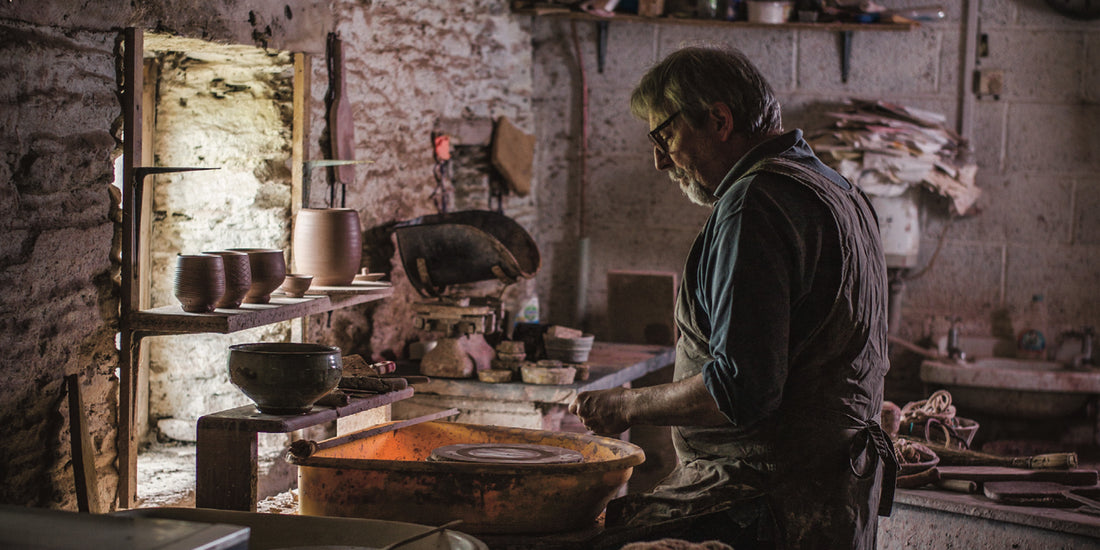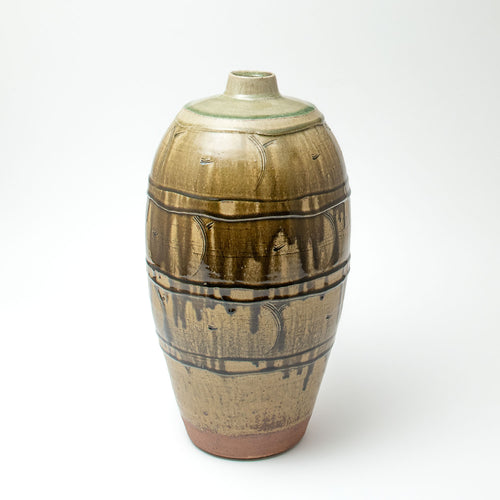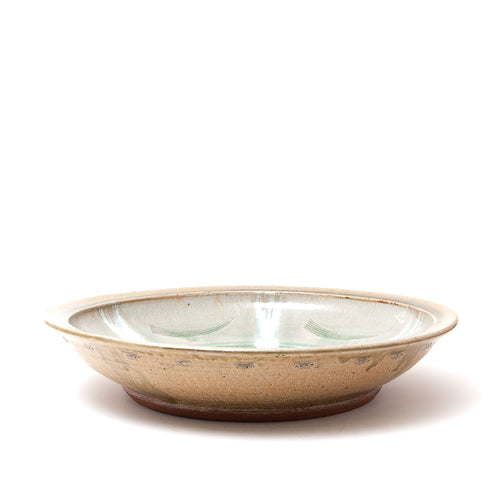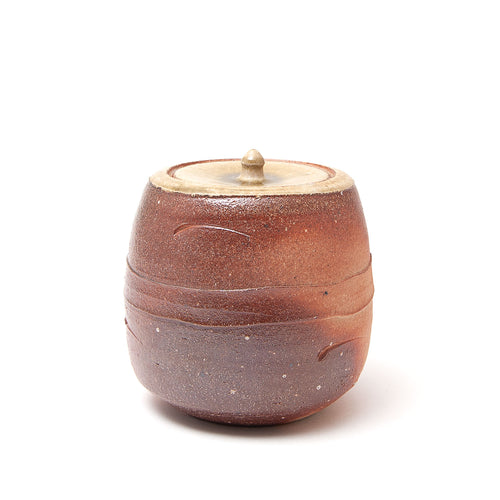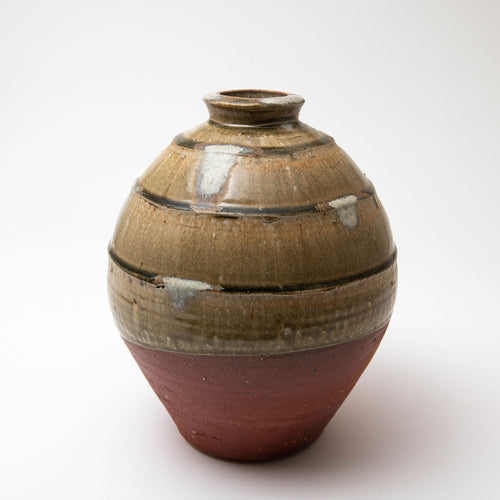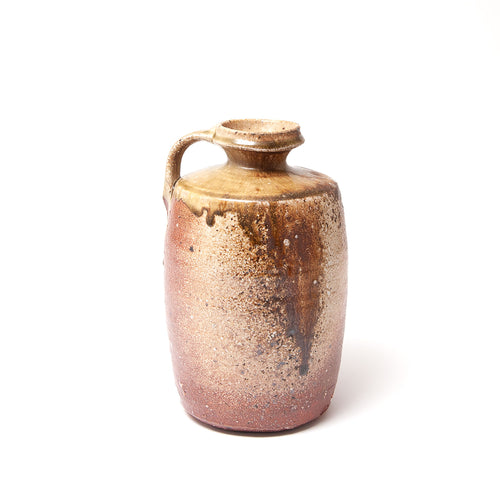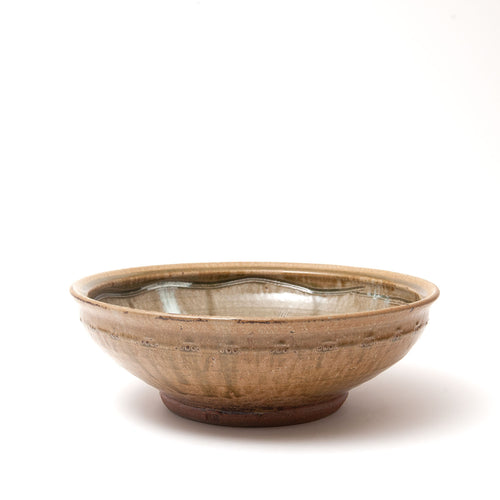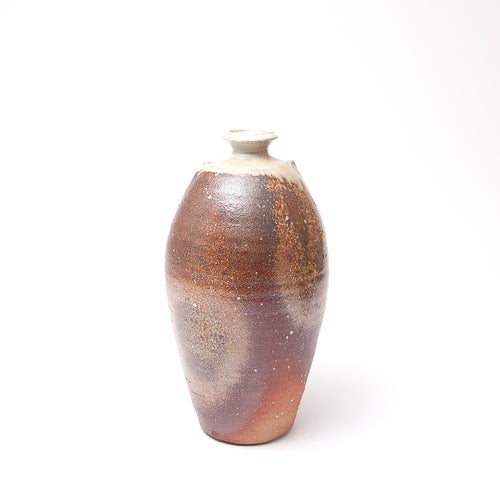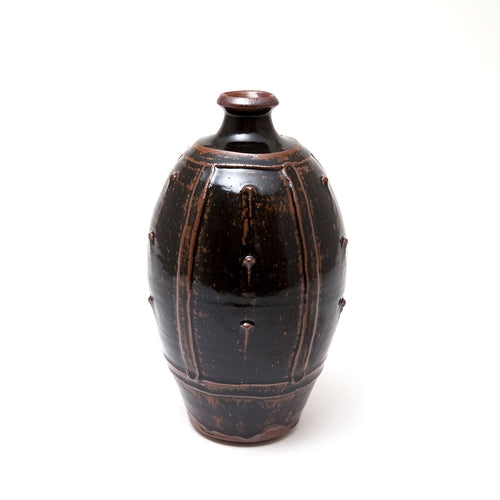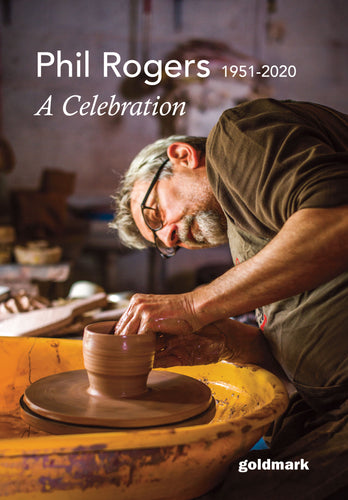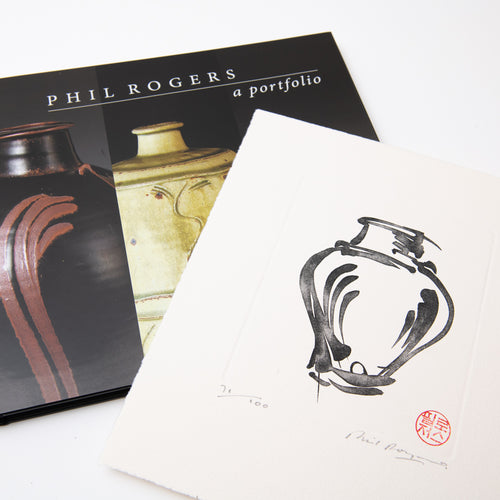Phil Rogers’ fifth Goldmark exhibition opened at the height of Covid lockdown. With no possibility of inviting people to the show, we instead brought the show to them with an online tour and talk with longtime friend and collector, the Reverend Richard Coles. Just weeks ahead of the republication of Phil’s renowned Ash Glazes book, we revisit their wonderful archival conversation.

Phil Rogers at his wheel
Richard Coles: I spoke to a farmer the other day, one of my parishioners, and I asked him ‘How are you doing with social isolation?’ He said I’ve been socially isolated since 1974. Not quite the same for you, Phil, but you do live on the edge of a town and you are a potter and you do work at home, so I guess your daily pattern of life has not been too interrupted.
Phil Rogers: I said almost exactly the same thing the other day, that I’ve been self-isolating for 42 years. No, we’re very lucky; we’ve got space outside. We’ve got a couple of fields we can walk in and loads of jobs to do. But it’s very strange how as soon as the lockdown started, the weather brightened up. We’ve had hot sunny days ever since really.
I think it’s been the loveliest and the most awful spring simultaneously that I can ever remember. We have the internet of course, which is allowing us to speak to each other now, but it’s also allowing people to see this wonderful show that you’ve done for Goldmark, your fifth. I’ve just had a walk around and it’s been terrific, for all the usual reasons, but there’s new stuff, Phil, some of it really striking. I love what you’ve been doing with Buncheong, where you’re using that Korean technique with that almost metal- like clay and then hakeme over it and those very simple decorative marks which remind me of a kind of Hamada vocabulary, if I can put it that way. That stuff’s now very prominent and strong in your work.
I’ve been working on it for a few years to try and get it as right as I can get it. I don’t know if it’s there yet, but it’s certainly developed over probably four or five years. I enjoy the physical act of doing it, in the knowledge that if it goes terribly wrong I can wipe it all off and do it again, which gives you a little bit of freedom. Hamada said that hakeme was at the same time the most simple of techniques and also the hardest technique because it’s easy to overthink it, to try to get an effect that is almost preconceived in a sort of way. You’ve just got to let go and, unless it’s a disaster, take what the brush gives you.
But you can only be free when you know intimately what you’re doing, can’t you – you can only let go when you’ve got something to let go, which is the decades of painstaking acquiring of skill and technique, and also discovering who you are, what kind of a potter you are, what kind of person or artist?
That’s true. I think a lot of that kind of technique, and it’s the same with brushwork, a lot of it is just confidence. The hardest thing for me, in that whole area of what I do, is brushwork because I’ve never really been a brushwork potter. I’ve always been known as somebody who decorated in the clay, and then relied on glazes to make that decoration interesting. That’s why I always use those fluid ash glazes. So the brushwork has been something of a challenge and finding two or three motifs that you can use that you feel are successful, without it looking pseudo or cheesy in a way. The hakeme is a little bit like when I draw in the clay, you just have to do it and you don’t think about it. I remember I was taught a little bit by my friend Lee Kang- hyo, who also shows at Goldmark. He’s a Korean Potter. At the time he was trying to show me how to do it, he couldn’t speak English and I couldn’t speak Korean. The only thing he kept saying to me was ‘No thinking, no thinking.’ That was all he could say: ‘No thinking!’ And I know exactly what he meant.

Bottle, straps, ash glaze. Wood fired
It’s so easy, isn’t it, to have conscious thought interrupting processes which are perhaps not fully conscious, and shouldn’t be conscious. The other thing I thought walking around this show was that if I didn’t have my specs and couldn’t see the detail that’s very distinctively you – the finger marks, the lugs, the pellets that you stick on the surface of a pot – I’d know it was you because of that distinctiveness of your Nuka, the salt, that lovely deep red glaze that you have. I love that high kink you have on the handle of a jug: you can see that from a hundred yards away and know that it’s you, even if all sorts of interesting new things are happening on the surface of the pot.
It’s very nice that you think that, and really satisfying. Having been making pots now professionally for 42 years, what keeps me interested is finding new avenues to explore. When I started, back in 1978, it was very much frowned upon if you tried too many different things. Your pots had to be of a certain type and sort, and you were encouraged to stay within certain strict parameters. When I was trying to become a member of the Craft Potters Association, I remember being rejected a couple of times because they felt that the pots were all over the place. As you get older, and as you’ve been in the business for a long time, that aspect changes to being a virtuoso. It’s now seen as something to be applauded that you’ve got these skills. And I have no worries about making very different pots as long as, as you say, they all look as though they were made by me.
One thing I’ve not seen before one is a sort of flower motif, deeply impressed and surrounded by marks made with a fork like scraper. And there’s a glaze which has a sort of tiger’s eye look to it, this amberish colour which goes to a dark, treacly brown; I’ve not seen that before.
In Japan they would call that glaze ame; it’s a brown, toffee treacly ash glaze, and I set out to make that glaze or as near to it as I could get. The flower decoration is a clay stamp I picked up in an antiques shop in Korea, which is meant for impressing rice cakes. I just use it in the clay instead.
These impressions and marks seem deeper and more emphatic to me in this show. There seems to be a lot more happening with the disruption to the surface of the pot than I’ve seen before – would that be fair to say?
Yes, I think so. Some of the dimpling is really tricky, because I have to throw the pot without a neck on it so that I can get my hand inside to be able to press in without completely distorting the pot.
The other thing I’m really enjoying are these really big dishes. There’s one I’ve just been looking at where you have that green glaze which pools in the base of a circular dish shape, and then it becomes glass-like and crackles. It’s beautiful thing.
Yes, that’s the pine ash glaze. Where it pools – how can I explain this without getting too boring – when the glaze is thinner, the clay underneath and any slips I’ve used have much more of an effect on the finished quality of the glaze. Where the glaze is thicker, because it’s run into those areas (in the kiln it becomes very fluid), it becomes more glass- like, as you say. There’s so much glaze on top that the clay beneath has less influence.
And again you have these deep, round impressions and you pour into that almost a ghost glaze, a very pale, white glaze that trickles down. You get this sense that there’s something very fluid and very uninterrupted happening, but around it you set parameters through these heavy marks, through the limits of the clay, through the shape of the pot. There is always this tension, isn’t there, between what is free and what is given. I love that about pots.
What you’re seeing is Nuka glaze on top of the ash glaze. To do that, all I do is wipe my finger around the bucket and get a lump ofcreamy glaze on my finger and literally just sort of place it on top of the pot. In the firing that glaze melts and runs down. I often feel, particularly as the dishes get bigger, the great expanse of that green ash glaze – even though the firing transforms the glaze and you do get extra things going on, especially if there are marks in the clay – I sometimes think that it just needs something else. And those Nuka runs that you’re talking about, which cascade down the side of the pot, I feel just gives the eye a way of entering into the space somehow.

Phil Rogers throwing a bowl
We have questions pouring in from all over the world: Argentina, India, Netherlands, Boston, Vancouver. This is a more general one from France: What are your sources of inspiration and which ones have priority?
I look at pots from different cultures and different ages and I look to contemporary work – not so much very contemporary, but certainly 20th century, though there are one or two British potters who are almost exact contemporaries and have been influences: people like Richard Batterham and Mike Dodd, who was probably about seven or eight years in before I got going. I’ve been interested in Korean ceramics right from the time I started. Chinese pottery, more when I started than now. There was a time when German salt glaze had a big influence on me, and settler pottery from all down the east coast of the United States, made by Dutch and German immigrant potters in the late 17th and 18th centuries. English slipware – I’ve never made slipware, but there is something about the way that slipware was decorated, going back to what we were talking about with hakeme. Someone decorating slipware pots two or three hundred years ago was probably making 50 or 60 pieces in a day. He didn’t have time to sit and think about it, he just had to do it. He’d made 50 or 60 the day before. It just became part of his hand, part of his personality, direct and unfettered.
What about outside pots? What about life? What influences your work that's outside the connection you’d have to other potters within that praxis?
That’s difficult to answer actually. Sometimes people say to me ‘Well you live in a beautiful place in the countryside’, but I honestly think my pots would probably be the same if I lived in the middle of Manchester.
Oh because we'd love to say, wouldn’t we, that it takes on the hues of the Welsh geology around you and it's full of the drama of the Welsh landscape and the distinctive interplay of light and water, but you think that's not the case?
I think it's partly true. Every day I take the dogs into the fields twice a day and I look around me at the leaves on the trees and the branches silhouetted against the sky and that filters in. But I can't honestly say that – hmm, difficult one. There are aspects to the decorations sometimes that I'll do on a pot where I put a wavy line around the body and then I've drawn a little plant-like thing around it. And that wavy line for me is landscape. It's hilltops, really. I look out of my window and I can see that wavy line across the valley on the top of the mountains. So there is that. But I still think that if I lived in the middle of London or the middle of a large city, I'd still be using ash glazes, I'd still be interested in Korean ceramics, I'd still probably be using the same sort of glazes, and maybe the decorations would be slightly different. But I still feel that it's more what you gravitate towards, really.

Phil Rogers with his dog
Maybe all that stuff is mysterious; it kind of creeps into your unconscious where so many of the decisions in art are made, if they are decisions. What about your Welsh, Phil? Obvious thing to say that you live in Wales. You're very rooted where you are in Rhayader. I remember that the place where you live, the architecture, often people are living in houses which are six or seven hundred years old and they conform to a very particular type. Being Welsh, is that important to you?
Oh yeah, very much. I mean, I'm Newport so I'm not Valleys Welsh, you know. Newport has always been a border town, so I don't have that rich Valleys accent. I wish I did have.

Phil's pottery set into the hills of mid-Wales near the River Wye
Whenever I go to the rugby and I hear Welsh people sing Calon Lan I want to be Welsh because I want to be part of something that has got such solidarity about it. In the 1980s, I was involved in helping support a pit village in the miners strike in the Dulais valley. And again, there's this kind of corporate thing, a sense of solidarity in community that I really, really loved and still do love. And that's interesting because you live a very solitary life. The tradition that you stand in is not a distinctively Welsh tradition. Your idea of extra time is going out metal detecting, which is hardly throwing yourself into a throng of people, but that's still resonant for you: this idea of the solidarity.
We're a small country, see. We're a very small country. I know that the arts community in its broadest sense is even smaller than Wales, but it's amazing how often I'll bump into people who I've never met who know somebody quite close to me. So we feel that because it's a small country, we sort of know everybody somehow.
But also I’ve noticed with Welsh artists that there's a kind of community which extends beyond the discipline. So it’s not just potters knowing potters, but you'd know painters, writers, weavers. It goes across those boundaries.
That's right. There’s a Kyffin Williams painting behind me – we were quite good friends for the last six or seven years of his life. There was a time when I was on the crafts board of the British Arts Council and I used to talk and interact with a lot of people. I don't see so many people these days, I have to say. My sort of committee life of Arts Council in Wales and with the Craft Potters Association and with Royal Cambrian – I'm not a meetings person really. Running the CPA for four years, there were a lot of meetings involved in that. I was quite happy and proud to do it, but I can't say I miss it.

Rogers throwing a small guinomi
It’s a bit like being the poet laureate isn't it? You'll never write anything while you're doing that because they’re such different roles. I also wonder about appropriating what others have done before you. You often get this with potters, don’t you, the idea that you stand on the shoulders of giants. Especially I think in Japan, those kind of family hierarchies. There’s a genealogy isn’t there, literally father to son sometimes, or in somewhere like Mashiko where you get a sense that there’s a community who know each other. It’s not just the single potter, but potters in relationship with one another that creates the discipline in which they work. It’s fertile.
That happens here too. I’m not talking about the father to son thing, although that certainly has happened – you think of Michael, Seth and Ara Cardew, there’s Bernard Leach, David and his sons, those things have happened.
When I started, back in 1978, it was very much frowned upon if you tried too many different things. As you get older, and as you’ve been in the business for a long time, that aspect changes to being a virtuoso.
I can only speak really within the genre of what I do. There are people within that genre who I’ve certainly fed off, and I’d like to think maybe they’ve fed off me to a certain extent, but because I’m younger than them it tends to be more one-way traffic. People like Mike Dodd and Richard Batterham, who I mentioned before – because we work in a similar way, have similar ideas about local materials, using ash and salt, finding different stone dusts to make glazes with and clay to make slips and so on, there’s a sort of commonality to it all.

Phil's two-chamber wood-kiln being unpacked
A question from another global viewer: could you expand on the tension between working with recurring themes and doing something new?
Anything new is always, for me, a development of something that I’ve already done. It’s never absolutely new. You are taking something and moving it to a different place. So for instance, with the Buncheong – I think in 2003 (I know that because one of the moulds has got it written in the plaster) I had a spell of really bad back pain and I wanted to get off the wheel for a bit, so I made some press moulds which allowed me to make pots without having to sit bent over. I used those moulds for years, and found different ways to glaze them, decorate them, treat them and so on. One of the fascinations of that was that you have two pots which are basically absolutely identical in the skeleton, because they come out of the same mould. But however you treat and decorate them, they take on hugely different personalities and characters because of the surface. As I wanted to bring the Buncheong work to the fore, I started off using the same mould, but actually then sat down one day and made three or four new moulds, new shapes.

Phil applies glaze to a chawan with a handmade brush
That’s very interesting. The word innovation, in theological terms, is slightly kind of disparaging in a way: we shouldn’t really be doing that, because we’re custodians of a tradition. But these new shapes in the Buncheong stuff – is the shape to an extent dictated by what’s happening with the hakame? I wonder what leads: is it what’s happening on the surface, or is it the shape of the pot?
When I’m throwing, I’ve got it in mind all the time: ‘What am I going to put on this later?’ So the pots are, as I’m throwing, sort of designed in a way to take certain glazes. 99 times out of 100, I’ll know when the pot comes off the wheel. I know what glaze is going on it. The thing that keeps me interested in making pots is working out new forms and new shapes. And I probably make too many new shapes, to be honest. Quite a few don’t ever make it into the kiln because they just don’t work. That’s what keeps me interested: trying to devise and think about new shapes, new forms and the way they’re orchestrated, the way they all fit together, the angles and so on, how it all comes to fruition. When I’m throwing, I’m constantly asking myself questions about the way a line is changing from one angle to the other. Where’s the shoulder going to be? What’s the height of the pot in relation to the width, the neck, the rim? Where’s the handle going to go? All of these questions, running through your head as you’re throwing. Sometimes it works beautifully, and other times you end up chucking it in the bin. That’s the thing that keeps me really interested, and as I say, I think I probably make too many new things.

Phil Rogers trims a bowl foot in his studio
The other side of the coin is that I was looking through my last catalogue, and a lot of those pots I could have made just yesterday. Two and a half years between shows, in terms of development of any creative suit but particularly pottery, because we have to wait so long for pots to dry and be fired and for kilns to cool and all of that – two and a half years is not very long. And so there are things that you do years ago that are actually very similar to the things that you do now.
I recently unearthed when I was tidying up (which doesn’t happen very often) a cache of old diaries and photo albums. The thing that was really fascinating about them was how the chronology in my memory is completely different from the actual chronology. When I look at the evidence, seeing the date on the back of a photograph, I find that events I thought were completely remote and unconnected to each other happened on the same day. I wonder if pottery, in a way, gives you a sort of biography or a CV that surprises you sometimes.
Yes, it does. And when it shows itself more than any other time is if I happen to come across a pot that I made, say, 10 years ago and I still remember who bought it and where it is now. That happens a lot.

the verdant countryside of the Mid-Wales valleys, near to Phil Rogers' Rhayader pottery
I’ve noticed that with potters that they do have a sort of ‘end-user’ part of their memory, as if the life of the pot doesn’t finish when it leaves the pottery. It has a life that continues in the collection and use of somebody else.
A funny thing happened this week. A guy that I knew 20 years ago who was a big collector – his collection was sold at auction, just a few days ago. And there were three of mine in the auction; one of them I felt was one of my better efforts, let’s say that! But I just couldn’t believe that it was made 20 years ago, because I could have made it last week. That’s the other side of it. Whilst you spend the last four or five years developing this Buncheong, which I’ve enjoyed doing, there’s this other pot, which was 20 years old, but could still have been made just recently.

Phil Rogers in his studio
Maybe there is a necessary forgetfulness in creative processes, so you feel that something is happening for the first time but actually it’s happened before. Anyway, now you’re a living National Treasure, Phil, and there are more red dots in this show than a measles epidemic. It’s been great to talk.
Well, thank you. When all this is over come back and have lunch again!
